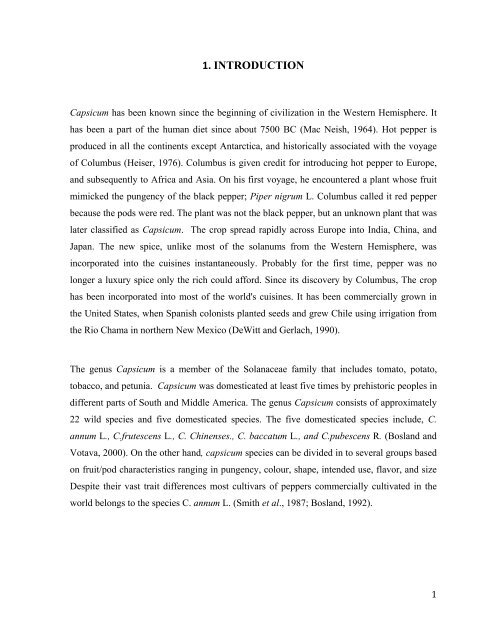EVALUATION OF ELITE HOT PEPPER VARIETIES - IPMS ...
EVALUATION OF ELITE HOT PEPPER VARIETIES - IPMS ...
EVALUATION OF ELITE HOT PEPPER VARIETIES - IPMS ...
You also want an ePaper? Increase the reach of your titles
YUMPU automatically turns print PDFs into web optimized ePapers that Google loves.
1. INTRODUCTION<br />
Capsicum has been known since the beginning of civilization in the Western Hemisphere. It<br />
has been a part of the human diet since about 7500 BC (Mac Neish, 1964). Hot pepper is<br />
produced in all the continents except Antarctica, and historically associated with the voyage<br />
of Columbus (Heiser, 1976). Columbus is given credit for introducing hot pepper to Europe,<br />
and subsequently to Africa and Asia. On his first voyage, he encountered a plant whose fruit<br />
mimicked the pungency of the black pepper; Piper nigrum L. Columbus called it red pepper<br />
because the pods were red. The plant was not the black pepper, but an unknown plant that was<br />
later classified as Capsicum. The crop spread rapidly across Europe into India, China, and<br />
Japan. The new spice, unlike most of the solanums from the Western Hemisphere, was<br />
incorporated into the cuisines instantaneously. Probably for the first time, pepper was no<br />
longer a luxury spice only the rich could afford. Since its discovery by Columbus, The crop<br />
has been incorporated into most of the world's cuisines. It has been commercially grown in<br />
the United States, when Spanish colonists planted seeds and grew Chile using irrigation from<br />
the Rio Chama in northern New Mexico (DeWitt and Gerlach, 1990).<br />
The genus Capsicum is a member of the Solanaceae family that includes tomato, potato,<br />
tobacco, and petunia. Capsicum was domesticated at least five times by prehistoric peoples in<br />
different parts of South and Middle America. The genus Capsicum consists of approximately<br />
22 wild species and five domesticated species. The five domesticated species include, C.<br />
annum L., C.frutescens L., C. Chinenses., C. baccatum L., and C.pubescens R. (Bosland and<br />
Votava, 2000). On the other hand, capsicum species can be divided in to several groups based<br />
on fruit/pod characteristics ranging in pungency, colour, shape, intended use, flavor, and size<br />
Despite their vast trait differences most cultivars of peppers commercially cultivated in the<br />
world belongs to the species C. annum L. (Smith et al., 1987; Bosland, 1992).<br />
1

















